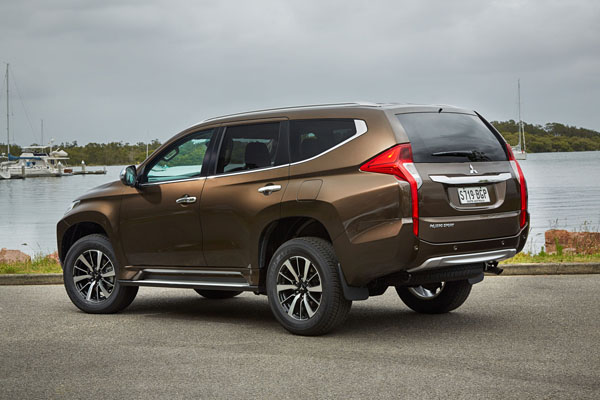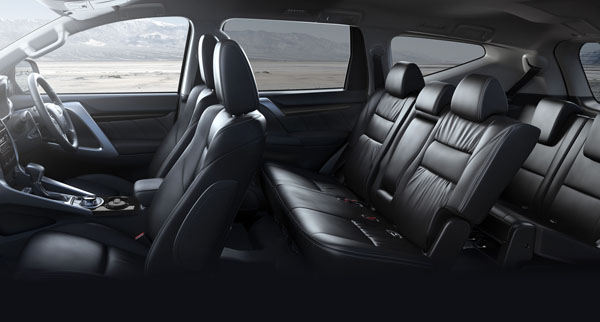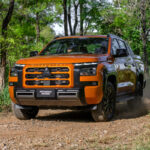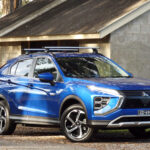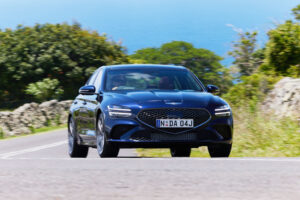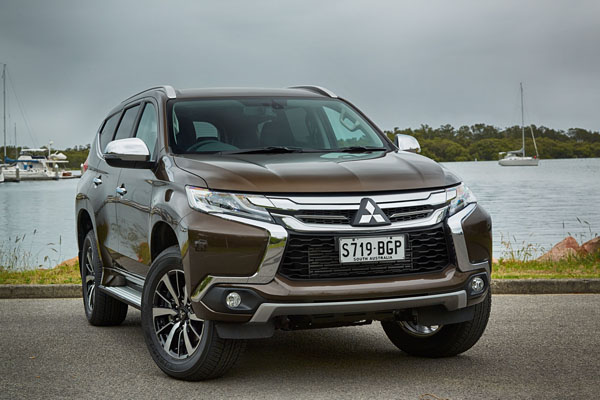
The Mitsubishi Pajero Sport has extended itself with the addition of a third row of seats, giving the big sports utility vehicle a fine balance of occupant comfort and cargo-carrying flexibility.
The Pajero Sport, the most technically advanced off-roader Mitsubishi has produced, replaces the Challenger and comes in three versions – GLX, GLS and Exceed – and continues to offer exceptional value and performance in the genuine 4×4 SUV class, with smooth eight-speed automatic transmission, thrifty 2.4-litre turbo-diesel engine and Super Select II four-wheel drive.
The well-specified GLX starts the ball rolling at $45,000, the GLS (the test vehicle), at $48,500, taking on added comfort and convenience features such as dual-zone air-conditioning, leather interior, rain-sensing wipers, dusk-sensing headlamps and electro-chromatic rear view mirror.
The range-topping Pajero Sport Exceed features the latest in advanced safety systems, with multi around monitor, blind spot warning, forward collision mitigation and Ultrasonic Miss-acceleration Mitigation System among its standard equipment. (The latter helps dopey drivers who accelerate instead of braking from ramming something.)
Mitsubishi’s new off-road terrain control and Super Select II all-wheel drive systems are fitted to every Pajero Sport. Along with rear view camera, reversing sensors, seven airbags, emergency stop signal, hill descent control, hill start assist and trailer stability assist systems, Pajero Sport boasts a long list of standard safety features. Mitsubishi’s five-year warranty and fixed-price servicing apply to the wagon.
STYLING
Mitsubishi has used the Pajero Sport to help introduce the company’s new Dynamic Shield styling theme, lending it a distinctive appearance from every angle, setting it apart from the competition.
Latest design 18-inch alloy wheels all add a robust character and a premium appearance. LED rear combination lamps have a unique vertical design, especially striking when in action.
However, it’s all about aerodynamics – a drag co-efficient of 0.04 Cd – in this case, among the best in class. The front bumper has been shaped to ensure the smooth flow of air along the sides, while the A-pillars are rounded and flush with the glass to reduce wind resistance.
Front air dams, ahead of the front tyres, reduce air resistance and suppress lifting force. Pajero Sport’s sides taper inward at the rear to smooth airflow separation and lower air resistance, while a front-end design decreases splash over the windscreen when driving through water.
INTERIOR
Occupants step up into a cabin with interior space bettered over its predecessor with more front seat headroom, and extra shoulder room in the second row. Reach-and-rake adjustable steering and seat slide travel ensures drivers of almost all sizes can find a comfortable seating position.
Uprated noise insulation has been used to achieve a calm interior, while the four-spoke leather steering wheel is functional with a sporty overtone. The latter incorporates cruise, audio and other controls with auto transmission paddle shifts mounted behind the wheel.
Sharply contrasting instrumentation contributes to a luxury appearance and a multi-information display in the dash panel provides information on fuel consumption, fuel range, eco-drive assistance, as well as drive and off-road modes.
INFOTAINMENT
Compatible smartphone connectivity is a given through Android Auto and Apple CarPlay. Users can connect to apps, including navigation, stored on their smartphone through the system’s 7-inch colour touch screen or via voice control.
The system also allows users to make calls or send SMS messages hands free. Smartphone Display Audio is standard on all Pajero Sport models. Digital radio is standard with all variants fitted with DAB, along with traditional AM/FM tuner.
ENGINES / TRANSMISSIONS
Mitsubishi’s uprated 2.4-litre turbo-diesel engine, launched in the 2016 Triton, produces 133 kW of power at 3500 rpm and 430 Nm peak torque at 2500 rpm.
Using aluminium cylinder block construction and other lightweight materials, the engine is lighter, more efficient and more powerful than its predecessor.
Fuel economy and emissions (Euro 5) have been improved by lowering the compression ratio to 15.5:1 and locating the diesel particulate filter as close to the engine as possible.
An all-new eight-speed automatic transmission has been given its first outing in a Mitsubishi vehicle and has been specially developed for Pajero Sport. It features a sophisticated adaptive control system which features uphill control to select the best ratio; downhill control, where lower gears are selected to support deceleration via engine braking; and accelerator pedal release control, in which upshifting is temporarily prevented when the accelerator pedal is rapidly released to provide engine braking and assist acceleration performance once the pedal is re-applied; and rapid kick-down control.
SAFETY
All Pajero Sport models have seven airbags – driver and front passenger, side, side curtain and driver’s knee, as well as Mitsubishi’s RISE (Reinforced Impact Safety Evolution) impact safety body.
Pajero Sport also has a range of active safety features, including ABS anti-skid braking with electronic brake force distribution, along with emergency stop signal, which warns following vehicles by flashing the hazard lights in an emergency braking situation or when ABS is activated.
Active stability and traction control stabilises the vehicle by regulating engine output and brake force when instability is detected through sudden steering inputs or one or more wheels slipping. It also restricts driving wheel spin to provide optimum drive force and traction.
Rear-view camera, reversing sensors and speed sensing auto door locking add to the list. The result is a five-star ANCAP safety rating.
DRIVING
The addition of a third row of seats to make a seven seater is all very well, but it does have its drawbacks. The front two rows of seats are easily accessible, generous in width and supportive but the back pair are a different matter.
Getting in and out is easy enough with the second row tumbling forward to leave good access. However, legroom is limited and fitting only for nippers. Ironmen need not apply.
With the rear seat backs folded flat there is a stack of room for gear, but with the third row in operation, the majority of space is gobbled up. A nice touch is a shallow compartment in the floor the full width of the back with a lid to hide smaller items from view.
The loading lip is high and the tailgate, without power operation, heavy and awkward to close.
Embedded satellite navigation is not installed. It is up to the user to download from Apple Carplay or Android Auto from a smartphone and operate through the touch screen or voice control; believe it or not, this is still not accessible to everyone, only smartphone owners.
The test Pajero greedily gulped up to 13.6 litres per 100 kilometres worth of diesel in the city and suburbs. However, this turned into a redeeming 5.6 litres per 100 kilometres on motorways at 110 km/h maximum. Reducing the speed to 100 km/h on the open road cut consumption even more, to 5.1.
The Pajero Sport has a tight, for its class, turning circle of 11.2 metres. Reduced lock-to-lock turns also improve ease of parking. Power assist has been calibrated to reduce steering effort when stationary or at low speeds while providing greater feedback at higher speeds.
All Pajero Sport models incorporate Super Select II four-wheel drive with dial-up 2H, 4H, 4HLc and 4LLc. Terrain off-road modes – gravel, mud / snow, sand, and rock – likewise can be selected. For horror stretches the Pajero Sport GLS can call on a rear differential lock.
SUMMING UP
As with all seven-seater SUVs the catchword is compromise and the Pajero Sport is no different. It’s either a full house with little space for gear, or it’s five up with enough room in the back for a reasonable amount of cargo. The choice is yours.
AT A GLANCE
MODEL RANGE
Pajero Sport GLX: $45,000
Pajero Sport GLS: $48,500
Pajero Sport Exceed: $52,750
Note: These prices do not include government or dealer delivery charges. Contact your local Mitsubishi dealer for drive-away prices.
FEATURES
18in alloy wheels with 265/60R18 tyres
LED headlamps, DRLs and rear combination lamps
2.4-litre MIVEC diesel engine
8-speed automatic transmission
Super Select II 4WD system
Off-road Terrain Control System
Hill Descent Control
Hill Start Assist
Trailer Stability Assist
Emergency Stop Signal, ABS/EBD/EBA
Electric park brake
Speed sensing auto door locking
Keyless entry, push button start
Tilt and telescopic steering wheel adjustment
Smartphone Link Display Audio, digital radio (DAB)
Rear view camera
Reversing sensors
Differential lock
Dusk sensing headlamps
Rain sensing wipers
Electro-chromatic rear view mirror
Dual zone A/C
Leather interior trim
SPECIFICATIONS (Mitsubishi Pajero Sport GLS 2.4-litre turbo-petrol 7-seat wagon)
ENGINE:
Capacity: 2.442 litres
Configuration: Four cylinders in line
Maximum Power: 133 kW @ 3500 rpm
Maximum Torque: 430 Nm @ 2500 rpm
Fuel Type: Diesel
Combined Fuel Cycle (ADR 81/02): 8.0 L/100km
CO2 Emissions: 212 g/km
DRIVELINE: Eight-speed automatic
DIMENSIONS, WEIGHT AND CAPACITIES:
Length: 4785 mm
Wheelbase: 2800 mm
Width: 1815 mm
Height: 1805 mm
Turning Circle: 11.2 metres
Kerb Mass: 2060 kg
Fuel Tank Capacity: 68 litres
BRAKES:
Front: Ventilated disc
Rear: Ventilated disc
STANDARD WARRANTY:
Five years / 100,000 km




